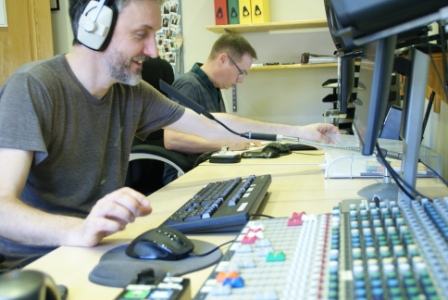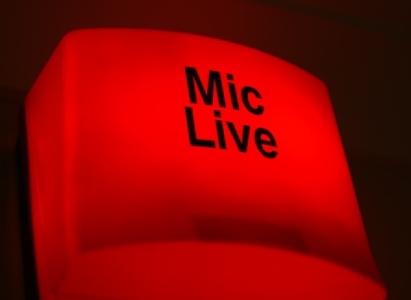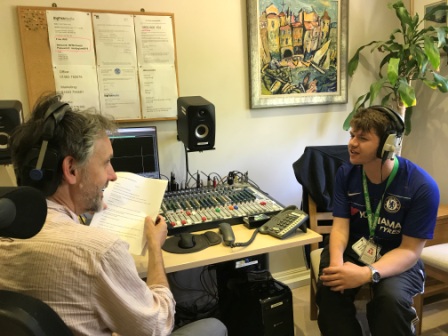Blog for Clients
Here you will find lots of useful information about casting, booking a voiceover artist, how a voiceover session works ands information about issues affecting the voiceover industry in general. If you are a voiceover artist, you may like to view our other blog: www.bigfishmediavoiceovers.blogspot.com
How Do I Book my Perfect Voiceover Artist?
Picture the scene. Your corporate video sits awaiting something. The graphics are completed, the animation works splendidly, the subtitles match the action and the music score is setting it off. But.
But there is something missing and you can’t quite put your finger on it? Well we know. That video is pining. And its pining for some real human value. Some real human connection. How can you solve that? Swipe right to find the perfect voice artist for your video. Here come the voiceovers:
But what are the ingredients that take your simple video production to the next level?
1. Take one finalised and checked and signed off script that appeals to the target audience and is written for speech.
2. Choose one of our fish-friendly voiceovers to elevate your production to real human level
3. Dial into our studio to direct the voiceover talent yourself
4. Have all the takes so that you can play with options and impress your client
5. Deliver a great video to your client
6. Clients brand product and/or service connects with their customers
And voila! You have finished your video dish off to perfection. It pays off in the long run simply because audiences and people need to hear stories, they need to connect to a brand or a product or service.
You can have a Daniel Pemberton or Spielberg to direct but without the words, what are you really trying to say?
Come and find your missing ingredient by contacting us here at BigFish Media. 
How Do I Ensure my Clients are Kept Informed during the Holiday?
Did you know that your customers are trying to find you? They are searching here and there. And in between watching the cat videos online and scrolling through their social media posts they are trying to see when you are open, what you sell and how soon they can get things and preferably not thrown in the bin or into next doors garden. And often they actually want to speak to someone or hear a friendly voice.
So what are you going to do about this? We know. You’ve covered all your bases. You have updated your website. Updated your social media. But hang on, are all your clients looking at social media? Are all your clients online? And more importantly have your clients got charged up phones to look at you online?
Sometimes clients don’t and they need to phone your store or business. So what do you do? Well tell them the latest news, opening hours and sales offers over the phone. How do you do this? Contact us today and we can inform them.
1. Choose a voiceover that best encapsulates your brand and or service
2. Send us the script so for example “Welcome to JustForYou Pies, we are open this season between 10 and 4, pop along for all your baking goodies”
3. We record the voiceover and send it to you in one of the many specialised telephony audio formats.
Your customers are kept abreast of your opening hours and offers.
We have produced audio for countless companies including the biggest in the building trade, Jewson. Find out how we can talk directly to your consumers using your words and our voiceovers by contacting us today.
How Do we Ensure your Audio Production sounds Amazing?
Did you know that we also provide sound design? Well we do and here at BigFish Media we have worked on Sound Design projects for years. Our in-house Sound Designer John, is an experienced artist and has created a variety of sound tracks for all sorts of clients. Sound Design is the creation of audioscapes for use in film, television, radio, theatre, live performance, musical composition, commercials and adverts for TV and radio, podcasts, video games and much more.
Sound Design can also include foley and development of sound effects and dialogue. John has worked on Video Games such as Perfect Dark, Starfox adventures, Sesame Street. John has also designed audio for films, podcasts, radio and IVR productions.
Having sound, music and effects in your audio production is as important as the copy. It adds atmosphere, authenticity and appeal to attract audiences and keep them interested.
Once upon a time, everything would have been live. However, as technology has progressed it means that the sound designer has to work hard too.
Every audio production really is underscored by having some sort of sound effects. The complexity and technical knowledge as well as a creative mindset mean that sound design is a real art.
Find out more and how sound design can have an effect on your audio production using sound and our voiceovers by contacting us today.
What Voiceover Moments have Changed the World?
Fishy has reminded us that it is time we let you know of the top moments that we feel have changed voiceover and speech over the decades.
Queen Victoria: This royal was seemingly recorded onto a wax cylinder. A clear regal voice is heard and if this should be Vicky then what a sound to have recorded. You can hear other clear voices here: voiceovers
Kings Speech: No, not quite the film but that moment when the Kings Speech was recorded and played out. One of us fine fish has visited the British Library Archives and held the actual disc that the speech made by the king (sans stutters etc) is held. A giant, heavy disc, engraved as if it were a vinyl shield. We also have a few voices that deliver that sort of performance with gravitas: voiceovers
Moon Landing: Oh now this is an exciting one – we heard a man on the moon speak out loud from the moon and it was transmitted from the MOON to EARTH (yikes) with technology much simpler than the phone you are using to read this and send pictures of your cat to your family whatsapp group.
What a thing – to actually hear voices from outside our world. And another thing that is out of this world is our list of amazing American Voiceovers. One small click for you and one giant leap for your production.
Robin Williams: We all wish we had a friend like Robin because he was the GENIE!! This is one of the first time that a well-known actor took on a featured role in an animation paving the way for other famous actors to take to the booth.
Previously the voice roles would have been done by a pool of talented actors who were mostly voiceover actors. Robin came, he recorded and he set the path of actors to act in animation. Hear our very own cheeky character and gaming voiceovers and get your own three wishes.
Don La Fontaine: Pray silence for the voice you have heard every Saturday evening when you went to the cinema and your whole body shook as you heard those immortal words “In a world…!”
A whole voiceover genre and standard was set and hardly any film trailer would be complete without his deep vocal cords flexing away. Here you can find your own movie trailer voiceovers in a world closer than you think.
Ashley Johnson: The first female to win a BAFTA Games awards in 2013. Her portrayal of Ellie in “The Last Of Us” was iconic and shone a light just how far video games have come. To hear other wonderful characters have a listen to character and gaming voiceovers. 
How Do I Direct Voiceover Artists?
When it comes to directing voiceovers in a recording session it is very easy – you just get them to speak the words on the script. But is it really that easy? Well yes and no.
Yes, in the sense that our voices are seasoned professionals and know by looking at the script if it is for a corporate, videogame, drama, IVR or documentary script and they instinctively understand how to voice it.
However, it also takes a director to ensure that the voiceover artist is speaking with the tone, pace, cadence, rhythm and musicality that the client or they are looking for. But how can you as a director direct?
Here are our top tips for voiceover directing:
1. Content – provide clear and correct copy ahead of time for the voice. Why is this important? Voiceover artists need to read the copy ahead of time so that they can get their mouth shapes around the words. They need to see what words and phrases may be trickier to pronounce or they may stumble over. Certain combinations of words or vowels or phrases may need extra practice. It may also mean it doesn’t work vocally and once you hear it, you may need to change the copy.
2. Context – What is the copy for? When and where is the copy set? Why is this copy important? All of these questions need to be answered which, as you or your client have written and signed off the copy, then this should be part of your direction when introducing the content to the voice talent.
3. Conversation – How do you want the voiceover artist to talk? Is it a conversation? It is a happy, angry, informative, busy, rushed or calm conversation? What pace do you want them to read at? What musicality are your trying to get them to voice? All of these questions are important to ensure the voice talent sets their tone and pace to match your copy and content.
4. Personality – Who is the voice in this piece? Are they the informer? The receiver? Are they guiding the audience? Are they eager, helpful, clever, authoritative or indecisive? Again these personality traits can help the voiceover artist set their intentions so that they can place the voice accordingly.
5. Listening – When you say action, listen and listen very carefully – they are not going to say this just once. So remain on the ball, after the third time of reading the script have you got enough options for you or your client? Do you even remember what they first take was like? Listen to them, listen to the voiceover artist so then you can advise when they need to do (if at all anything) on the subsequent takes.
These are just some top tips so that you can start to understand what it means to direct. It takes years of experience to understand and have the instinct to know what makes good takes for a client. We’ve been directing collectively for over 50 years so we know a thing or two about content and context and our voiceovers. Call us and find out how we direct so you get some really reel audio. 
What is Usage for a Voiceover Artist?
This is the final post on this series of rights for voiceovers. Right, we’ll walk you through it. Usage. What exactly is usage?
Usage is what we refer to when a piece of audio (i.e. voiceover recording) is used. There are many ways a piece of audio can be used. Some usages will incur more money because they are being used as a radio, TV or online advert to recruit new consumers or to retain existing consumers.
In simple terms usage is the licence fee that clients should pay to use your voice. This is on top of your recording fee or basic studio fee (BSF).
Below is a very short list of uses of voiceover and if they would then have more monies attached to them.
1. TV Commercial – Usage is incurred – prices are based on which TV stations the advert will air on or its TVR’s (Television Ratings) which is based on the potential audience
2. Radio Commercial – Usage is incurred – prices are based on which Radio stations the advert will air on. This fee is based on the size of the audience of each station
3. Online Commercial – Usage is incurred – prices are based on duration of campaign, which websites are being used and the impressions that the client is buying. The impressions are based on the size of the audience to be reached
4. IVR – prices are based on a fee per prompt.
5. Web Video – Prices are based on the size of the end client and duration that the audio is to be used for and hence the size of the potential audience
6. TV Documentary – Prices are based on the channel(s) that the documentary will air on and hence the size of the audience.
7. Corporate Video – used internally within the client’s company and no usage is payable
There are many other scenarios of course but these are the most common.
The reason many recordings have usage attached to them is that this is a performance and the voiceover artist is licensing their voice for you and your client’s (normally commercial and branding) purposes.
As well as all the other rights we have discussed, the key is equitable remuneration. The voice talent is allowing you to use their voice for the media and duration that you have agreed to and should be paid a decent rate for the job. Should you use in some other way without paying a further licence fee, then you have effectively broken the law (see the rights series of blogs).
Also think about it, the voiceover artist has worked hard, in fact most voice talents actually have a day job because they are mostly actors where jobs come up infrequently. They have studied hard, read out loud soliloquies from hamlet countless times so you don’t have to (honestly the one about flesh melting is just too raw for me even today and I still dream about it), they have worked on unpaid jobs to get material for showreels and scraped money together for audio reels.
They have practiced their vocal exercises, their intentions, their archetypes over and over and over again (and over) so they can deliver the best vocal performance. They understand either instinctually or through decades of work what it is to know how to cut off a couple of seconds in a radio ad to make it fit, how to change the musicality of copy, how to sound tall and blond when they are petite and brunette, how to work the pace and tone so that the client has several emotional states to choose from.
These voices are instruments that they have curated, that they have worked on as if it is a carpenter lathing away at a piece of wood. So yes, they more than deserve usage, they more than deserve to be paid for you to use their voiceovers in the way that we have agreed.

